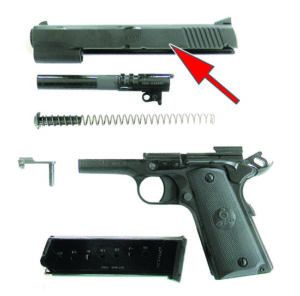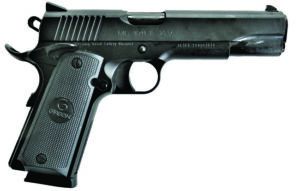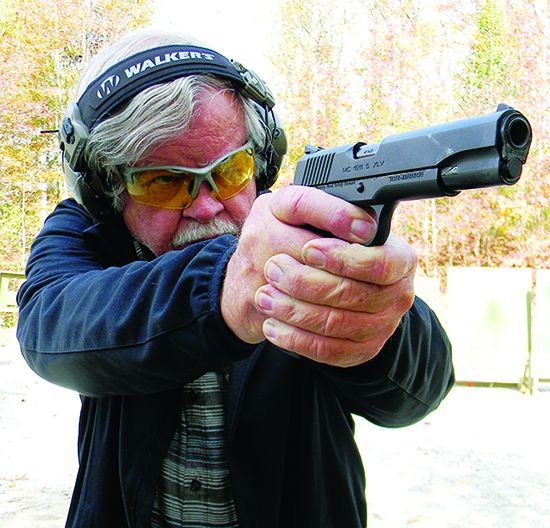Here, we face off three Government Model 1911 45 ACP handguns — a durable choice for home defense or concealed carry. But by no means are they tiny 9mms like we have tested recently. Instead, all three of these big bores have steel slides, and two have steel frames. Two have improved sights and controls, and one is a modest update of the GI gun.
Our first test gun was the Colt Government Model O1911C-SS 45 ACP, $1008. We found the Colt for sale in blued finish for $866, but we purchased the stainless version at the advice of a senior rater. He maintains that stainless-steel Colts are generally fitted better than their blued-steel variants. This may be true. We also could have purchased an XSE version with Novak sights and forward cocking serrations for $10 more. Just the same, this is a traditional Colt that fills many needs well, and many experienced shooters will prefer the Colt nameplate for its investment value as well as its shooting value.
As with the others, the EAA-Girsan MC1911S XLV 393060 45 ACP, $570, features a 5-inch Government Model-length barrel. Rather than the common target-style trigger found on the Colt and other 1911 handguns, the trigger on this one is solid. In common with the other pistols, the Girsan features a flat magazine housing.

If a pistol is manufactured of good material and functions properly at a fair price, it should sell well, and this is the niche the Tisas-SDS Imports 1911 Duty Stainless Steel Pistol 1911DSS45 45 ACP, $582, wants to fill. It featured both a forged slide and a forged frame in common with the Colt pistol. Longevity should not be a problem. The Tisas Service Duty pistol — the Service Duty Enhanced is a rail gun — is delivered in a hard-plastic case with a single magazine. The polish isn’t quite up to the Colt pistol, but it is far ahead of the Girsan.
We treated all three pistols to the same evaluation. We cleaned out excess packing grease first and then lubricated the barrel hoods, barrel bushings, cocking locks, and slide rails. To check universal function with existing magazines, we used one of the rater’s boxes of proven magazines. Of course, we used the new magazines included with the handguns. There were 42 all told. We broke open 300 rounds of 45 ACP full-metal-jacket ammunition, which were an even mix of Remington 230-grain and Federal American Eagle 230-grain ball. We loaded the seven- and eight-round magazines and Wilson Combat and Chip McCormick 10-round magazines and ran 100 rounds through each pistol. We also fired modern hollowpoint loads to judge accuracy, including Speer 200-grain Gold Dot +P and Federal 230-grain HST cartridges. Here’s what we found when we took these three 45 ACP-chambered handguns to the range.
EAA-Girsan MC1911S XLV 393060 45 ACP,
$570
GUN TESTS GRADE: D
We were disappointed with the Girsan 1911, especially after excellent results with their Hi-Power clones. The pistol simply would not function.

| Action Type | Semi-auto, single action short recoil-operated locked breech |
| Overall Length | 8.5 in. |
| Overall Height | 5.5 in. |
| Maximum Width | 1.25 in. |
| Weight Unloaded | 39.0 oz. |
| Weight Loaded | 44.0 oz. |
| Slide | Black carbon steel |
| Slide Retraction Effort | 19.0 lbs. |
| Receiver | Black carbon steel |
| Front Strap Height | 2.6 in. |
| Back Strap Height | 3.2 in. |
| Barrel Length | 5.0 in. |
| Grip Thickness Maximum | 1.25 in. |
| Grip Circumference | 5.2 in. |
| Magazine | One 8-round |
| Rear Sight | Drift adjustable U notch |
| Front Sight | Dovetailed post |
| Sight Radius | 6.4 in. |
| Trigger Pull Weight | 7.5 lbs. |
| Trigger Span | 2.8 in. |
| Safeties | Slide lock, grip |
| Warranty | Limited lifetime |
| Telephone | NA |
| Website | EAACorp.com |
| Made In | Turkey |
Despite the pistol’s modest price — about the same as a Rock Island 1911 with similar features — the Girsan features ambidextrous safety levers. Indent of the safety lever isn’t mushy, but neither is the indent sharp. The grip safety is an upswept type with memory groove. A properly set up 1911 grip safety should release its hold on the trigger about halfway through its compression. This one has overtravel. We could have reset the leaf spring that controls the trigger sear and grip safety, but we left the spring as issued. We don’t think it would have changed the pistol’s performance in the areas below.
The slide is bar stock, while the frame is investment cast. The finish is some type of Cerakote. As close-up photos reveal, the application isn’t very smooth. During the trial run, there was finish degradation on the slide and internally on the long bearing surfaces.
The sights are a slanted rear sight similar to the Novak but not equaling the Novak. The front sight is a small post dovetailed in place. The sight picture is acceptable. The pistol doesn’t feature forward cocking serrations, as the Tisas did. Fit of the barrel hood and barrel bushing to the slide are acceptable. No tool is needed for field strip. The feed ramp exhibited the standard 1⁄32-inch gap between the frame and barrel portions of the ramp.
Trigger compression is not smooth at all, with considerable creep eventually breaking at 7.7 pounds. At the end of the test period, trigger pull weight lowered incrementally to 7.4 pounds. The grips are plastic checkered slabs similar to the Tisas. There is a small serrated area cut into the front strap. Neither the Colt nor the Tisas had any type of front-strap treatment.
The Girsan was supplied with a single Mec-Gar magazine. During the first 50 rounds, the Girsan exhibited short-cycle malfunctions in which the slide did not completely close. The cartridge was unable to complete its feed cycle, but never hung on the feed ramp. Six times in the first 50 rounds isn’t promising, and we were using magazines and ammunition proven in previous testing. While a break-in period is acceptable if it disappears during the first few magazines of ammunition, we seldom encounter break-in malfunctions with modern handguns. These are most often limited to 1911 handguns. On two separate occasions, at about round 50 and about round 70, the Girsan failed to pick up the cartridge-case rim during the feed cycle. The 1911 requires the cartridge to come up from the magazine. The cartridge-case rim must be caught under the extractor as the cartridge nose bumps off the feed ramp into the chamber. While the 45 ACP cartridge headspaces on the case mouth, a properly set extractor is important not only for the feed cycle but also for headspacing. The extractor may have been at fault in the short cycles; the barrel link may have been too long. During the last 50 rounds, we endured the two extractor-related malfunctions and four additional short cycles.
When the pistol functioned, we were able to get a good feel for the Girsan’s combat ability. The sights are properly regulated for 230-grain loads, and the pistol handles like a 1911 should — fast on target and fast to a center hit. Just the same, we fired two five-shot groups with the Federal American 230-grain FMJs and suffered two malfunctions. The average was 4.0 inches.
Our Team Said: Our hands-on inspection of the Girsan detected several flaws. The trigger is heavy, the slide-lock safety is mushy, and the grip safety was improperly set, and we had ongoing malfunctions. The pistol may be a good starting gunsmith project; it would probably respond to extractor tuning. But if it isn’t the link, there are better handguns for the same money or less. We’d pass on this one.
Both the Tisas and the Girsan feature a well-designed ambidextrous safety lever. This leaves the Colt out of the running. As a result, a left-handed shooter should not buy the Colt, firmly establishing the Tisas as the Best Buy.
| 45 ACP Range Data | |||
| Speer Gold Dot Carry Gun 200-grain +P 24258 | EAA-Girsan MC1911S XLV | Colt Gov’t Model O1911C-SS | Tisas-SDS 1911 Duty Stainless |
| Average Velocity | NA* | 1050 fps | 1079 fps |
| Muzzle Energy | NA | 490 ft.-lbs. | 517 ft.-lbs. |
| Small Group | NA | 1.8 in. | 2.2 in. |
| Average Group | NA | 2.4 in. | 3.0 in. |
| Federal American Eagle 230-grain FMJ | EAA-Girsan MC1911S XLV | Colt Gov’t Model O1911C-SS | Tisas-SDS 1911 Duty Stainless |
| Average Velocity | 855 fps | 844 fps | 860 fps |
| Muzzle Energy | 373 ft.-lbs. | 364 ft.-lbs. | 378 ft.-lbs. |
| Small Group | 3.6 in. | 2.0 in. | 2.4 in. |
| Average Group | 4.0 in. | 2.5 in. | 2.7 in. |
| Federal Premium HST 230-grain HST JHP P45HST25 | EAA-Girsan MC1911S XLV | Colt Gov’t Model O1911C-SS | Tisas-SDS 1911 Duty Stainless |
| Average Velocity | NA* | 847 fps | 835 fps |
| Muzzle Energy | NA | 366 ft.-lbs. | 356 ft.-lbs. |
| Small Group | NA | 1.8 in. | 2.4 in. |
| Large Group | NA | 2.3 in. | 2.75 in. |
We fired groups at 25 yards from a benchrest position using an MTM Case-Gard K-Zone Shooting Rest. We used a Competition Electronics Pro Chrony to measure muzzle velocities. *The Girsan was not fully tested because of malfunctions.
Written and photographed by Gun Tests Staff, using evaluations from Gun Tests Team members. GT


























That’s been my experience with EAA 1922-style .45s. They apparently just don’t know how to make a decent one.
I’ll continue with my CZ75.
my Kimber Polymer Target has about 26K rounds through it now and it functions perfectly.
I had it resprung and the feedramp polished at about 22K rounds.